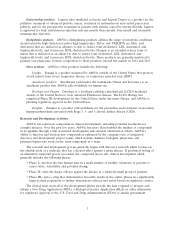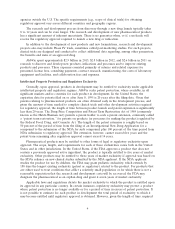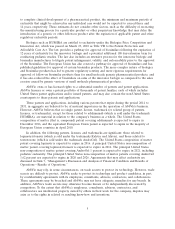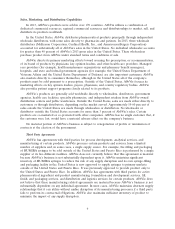AbbVie 2013 Annual Report Download - page 17
Download and view the complete annual report
Please find page 17 of the 2013 AbbVie annual report below. You can navigate through the pages in the report by either clicking on the pages listed below, or by using the keyword search tool below to find specific information within the annual report.adversely affect its business. In addition, past financial performance may not be a reliable indicator of future
performance, and historical trends should not be used to anticipate results or trends in future periods.
If any of the following risks and uncertainties develops into actual events, these events could have a
material adverse effect on AbbVie’s business, financial condition or results of operations. In such case, the
trading price of AbbVie’s common stock could decline.
Risks Related to AbbVie’s Business
The expiration or loss of patent protection and licenses may adversely affect AbbVie’s future revenues and
operating income.
AbbVie relies on patent, trademark and other intellectual property protection in the discovery,
development, manufacturing, and sale of its products. In particular, patent protection is, in the
aggregate, important in AbbVie’s marketing of pharmaceutical products in the United States and most
major markets outside of the United States. Patents covering AbbVie products normally provide market
exclusivity, which is important for the profitability of many of AbbVie’s products.
As patents for certain of its products expire, AbbVie will or could face competition from lower
priced generic products. The expiration or loss of patent protection for a product typically is followed
promptly by substitutes that may significantly reduce sales for that product in a short amount of time.
If AbbVie’s competitive position is compromised because of generics or otherwise, it could have a
material adverse effect on AbbVie’s business and results of operations. In addition, proposals emerge
from time to time for legislation to further encourage the early and rapid approval of generic drugs.
Any such proposals that are enacted into law could worsen the effect of generic competition.
AbbVie’s principal patents and trademarks are described in greater detail in Item 1, ‘‘Business—
Intellectual Property Protection and Regulatory Exclusivity’’ and Item 7, ‘‘Management’s Discussion and
Analysis of Financial Condition and Results of Operations—Results of Operations,’’ and litigation
regarding these patents is described in Item 3, ‘‘Legal Proceedings.’’ The United States composition of
matter patent for HUMIRA, which is AbbVie’s largest selling product and had worldwide sales of
approximately $10.7 billion in 2013, is expected to expire in December 2016, and the equivalent
European Union patent is expected to expire in the majority of European Union countries in April
2018. Because HUMIRA is a biologic and biologics cannot be readily substituted, it is uncertain what
impact the loss of patent protection would have on the sales of HUMIRA.
AbbVie’s major products could lose patent protection earlier than expected, which could adversely affect
AbbVie’s future revenues and operating income.
Third parties or government authorities may challenge or seek to invalidate or circumvent
AbbVie’s patents and patent applications. For example, manufacturers of generic pharmaceutical
products file, and may continue to file, Abbreviated New Drug Applications (ANDAs) with the United
States Food and Drug Administration (FDA) seeking to market generic forms of AbbVie’s products
prior to the expiration of relevant patents owned or licensed by AbbVie by asserting that the patents
are invalid, unenforceable and/or not infringed.
Although most of the challenges to AbbVie’s intellectual property have come from other
businesses, governments may also challenge intellectual property rights. For example, court decisions
and potential legislation relating to patents, such as legislation regarding biosimilars, and other
regulatory initiatives may result in further erosion of intellectual property protection. In addition,
certain governments outside the United States have indicated that compulsory licenses to patents may
be sought to further their domestic policies or on the basis of national emergencies, such as HIV/AIDS.
If triggered, compulsory licenses could diminish or eliminate sales and profits from those jurisdictions
and negatively affect AbbVie’s results of operations.
13
























